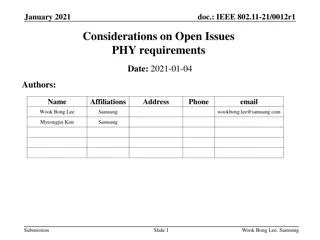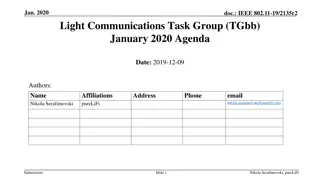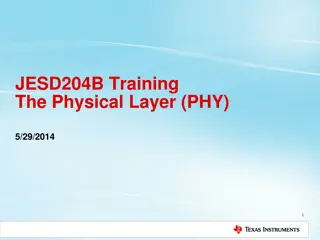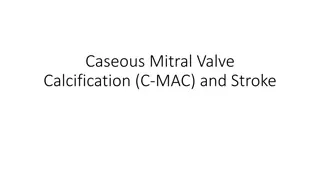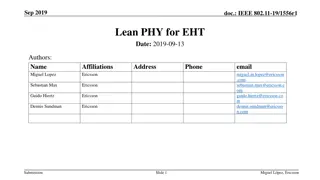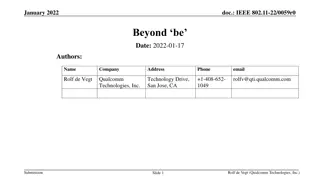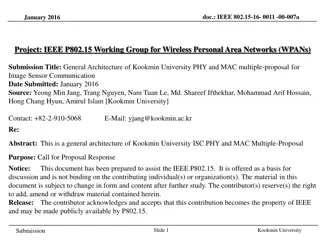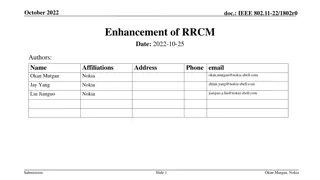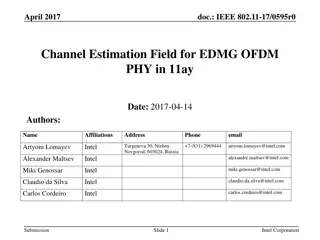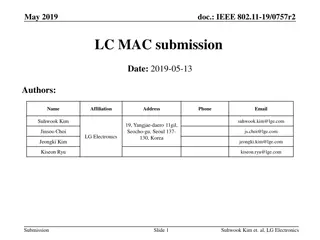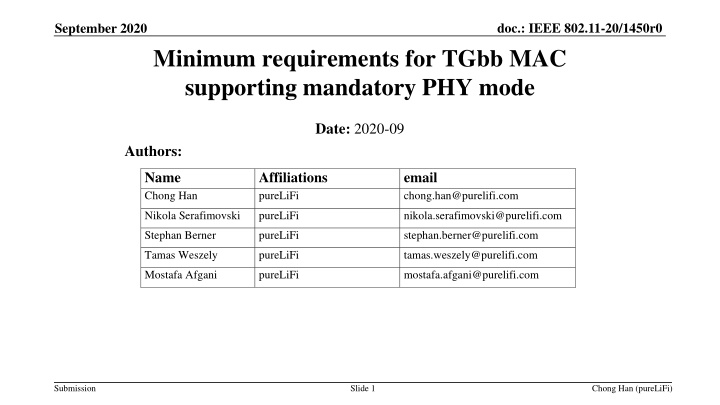
IEEE 802.11-20/1450r0: Minimum Requirements for TGbb MAC Support
Explore the minimum requirements for TGbb MAC supporting mandatory PHY mode as presented in IEEE 802.11-20/1450r0. Topics include channel access, fragmentation, multirate support, and architectural services. Learn about DCF, HCF, EDCA, and more essential mechanisms for enhanced wireless transmission capabilities.
Download Presentation

Please find below an Image/Link to download the presentation.
The content on the website is provided AS IS for your information and personal use only. It may not be sold, licensed, or shared on other websites without obtaining consent from the author. If you encounter any issues during the download, it is possible that the publisher has removed the file from their server.
You are allowed to download the files provided on this website for personal or commercial use, subject to the condition that they are used lawfully. All files are the property of their respective owners.
The content on the website is provided AS IS for your information and personal use only. It may not be sold, licensed, or shared on other websites without obtaining consent from the author.
E N D
Presentation Transcript
doc.: IEEE 802.11-20/1450r0 September 2020 Minimum requirements for TGbb MAC supporting mandatory PHY mode Date: 2020-09 Authors: Name Chong Han Affiliations pureLiFi email chong.han@purelifi.com Nikola Serafimovski pureLiFi nikola.serafimovski@purelifi.com Stephan Berner pureLiFi stephan.berner@purelifi.com Tamas Weszely pureLiFi tamas.weszely@purelifi.com Mostafa Afgani pureLiFi mostafa.afgani@purelifi.com Submission Slide 1 Chong Han (pureLiFi)
doc.: IEEE 802.11-20/1450r0 September 2020 Abstract The presentation provides the review of minimum requirements of the mandatory MAC for TGbb. The clauses/subclauses referred in the slides come from IEEE802.11v2016. Submission Slide 2 Chong Han (pureLiFi)
doc.: IEEE 802.11-20/1450r0 September 2020 Channel access Distributed Coordination Function (DCF) (10.3) carrier sense multiple access with collision avoidance (CSMA/CA) RTS/CTS Hybrid Coordination Function (HCF) (10.22) The HCF combines functions from the DCF with some enhanced, QoS-specific mechanisms and frame subtypes to allow a uniform set of frame exchange sequences to be used for QoS data transfers. Enhanced Distributed Channel Access (EDCA) mechanism for contention-based transfer (10.22.2). Suggested to be included in order to enhance transmission capability in terms of QoS. HCF Controlled Channel Access (HCCA) mechanism for contention-free transfer Submission Slide 3 Chong Han (pureLiFi)
doc.: IEEE 802.11-20/1450r0 September 2020 Fragmentation and Defragmentation Fragmentation (10.5) The MAC may fragment and reassemble directed MSDUs or MMPDUs. Defragmentation (10.6) Each fragment contains information to allow the complete MSDU or MMPDU to be reassembled from its constituent fragments. The fragmentation and defragmentation mechanisms allow for fragment retransmission. Submission Slide 4 Chong Han (pureLiFi)
doc.: IEEE 802.11-20/1450r0 September 2020 Multirate support (10.7) Some PHYs have multiple data transfer rate capabilities that allow implementations to perform dynamic rate switching with the objective of improving performance. Submission Slide 5 Chong Han (pureLiFi)
doc.: IEEE 802.11-20/1450r0 September 2020 Architectural services (1) a) Authentication b) Association c) Deauthentication d) Disassociation e) Distribution f) Integration g) Privacy h) Reassociation i) MSDU delivery j) Higher layer timer synchronization (QoS facility only) k) QoS traffic scheduling (QoS facility only) Submission Slide 6 Chong Han (pureLiFi)
doc.: IEEE 802.11-20/1450r0 September 2020 Architectural services (2) SS (The service provided by STAs) (4.4.2) a) Authentication b) Deauthentication c) Privacy d) MSDU delivery e) Higher layer timer synchronization (QoS facility only) f) QoS traffic scheduling (QoS facility only) DSS (The service provided by the DS) (4.4.4) a) Association b) Disassociation c) Distribution d) Integration e) Reassociation f) QoS traffic scheduling (QoS facility only) PBSS control point service (PCPS) (4.4.3) is not required. Submission Slide 7 Chong Han (pureLiFi)
doc.: IEEE 802.11-20/1450r0 September 2020 Authentication and privacy Authentication service: Open System (12.3.3.2) Shared Key (12.3.3.3) Encryption protocols: Required: Open connection Counter mode (CTR) with Cipher-Block Chaining Message Authentication Code (CBC-MAC) protocol (CCMP) (12.5.3) Optional: Temporal key integrity protocol (TKIP) (12.5.2) Galois/Counter Mode Protocol (GCMP) (12.5.5) Submission Slide 8 Chong Han (pureLiFi)
doc.: IEEE 802.11-20/1450r0 September 2020 Power management Required: Power management with Automatic Power Save Delivery (APSD) (11.2.3.5) Tunneled Direct-link Setup (TDLS) peer power save mode (11.2.3.14) Tunneled Direct-link Setup (TDLS) peer U-APSD (TPU) (11.2.3.15) Optional: PSMP power management (11.2.3.13) FMS power management (11.2.3.16) TIM broadcast (11.2.3.17) WNM sleep mode (11.2.3.18) VHT TXOP power save (11.2.3.19) Power management in an MBSS (11.2.5) SM power save (11.2.6) Power management in a PBSS and DMG infrastructure BSS (11.2.7) Modifications: Use 11.2.2.4 (ATIM and frame transmission) in IEEE802.11v2005 to replace 11.2.8 (ATIM frame and frame transmission in IBSS, DMG infrastructure BSS, and PBSS) Submission Slide 9 Chong Han (pureLiFi)
doc.: IEEE 802.11-20/1450r0 September 2020 Conclusion The document provides a guidance for the minimum requirements running mandatory PHY. QoS is enhanced by making EDCA, and APSD power management mode mandatory. Power management mode for Tunneled Direct-Link Setup is provided. Security is enhanced by adopting secure encryption protocol CCMP, while with TKIP and GCMP as optional encryption protocols. Submission Slide 10 Chong Han (pureLiFi)



